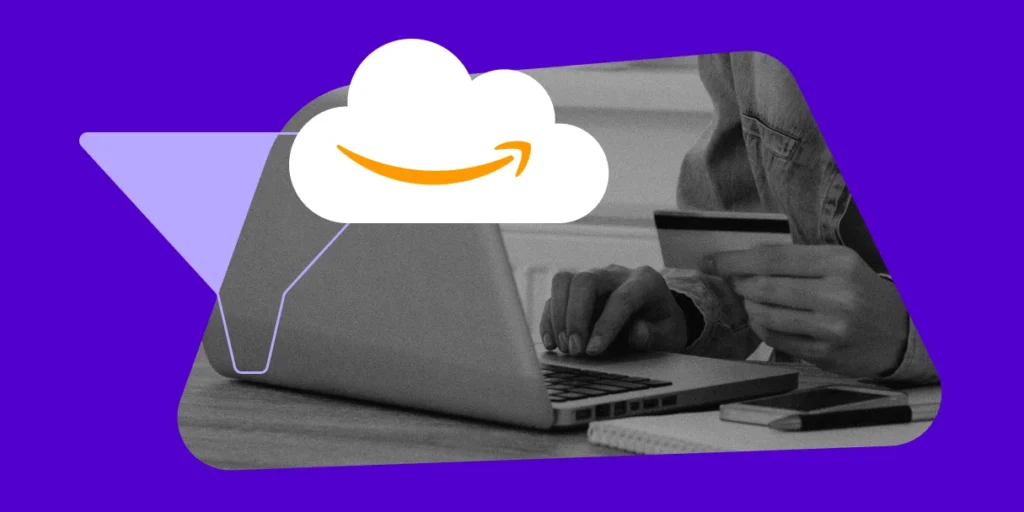What does it take to launch a fair trade business in the age of Amazon?
A lot more than you think.
SLATE + SALT is a fair trade/ethical ecommerce apparel and home goods company based in Florida.
This two-woman show launched in February 2017. Since then, the founder, Lyndsay Hugues, has learned what it really means to take a good concept–sourcing products from local artisans over the globe rather than sweatshops–and put it into (grueling) practice.
Fair trade has been trending since 2014, but that doesn’t mean that everyone in the US has transitioned over. Fast fashion lives on, mainly due to trendy styles with irresistibly low price tags.
And competing with Amazon is tough, because let’s face it–anything they sell is going to be cheaper than 80% of sellers out there.
We sat down with Hugues to find out the challenges she faces in the fair trade apparel and home goods space, and how to show customers value that goes beyond a price tag.
Advertising Fair Trade Products Online
From Facebook Dynamic Ads to Google’s Display Network, the platforms and options for online ads are virtually limitless.
Because the brand is so new, Hugues strategy is focused on gaining brand awareness, not necessarily hard sales. Here are a few key ways Hugues is currently focusing her efforts.
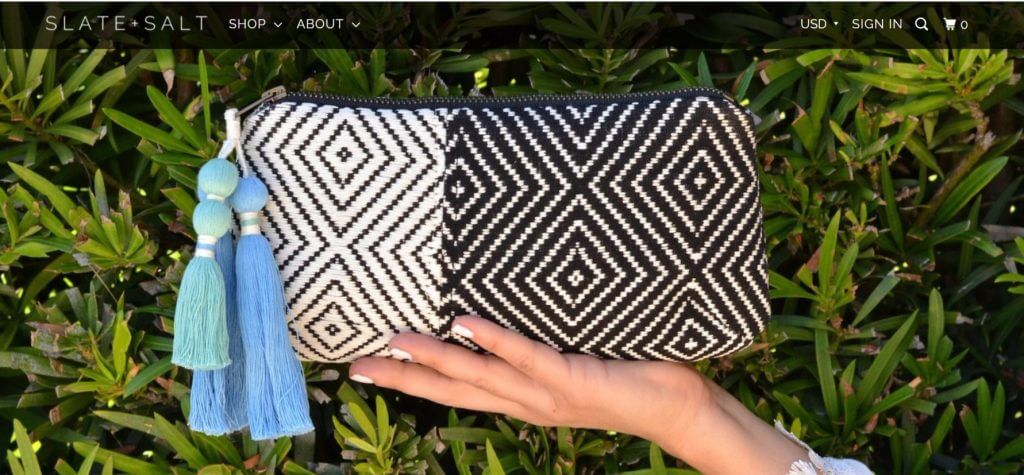
Gaining Brand Awareness Via Retailers & Ethical Publications
Although SLATE + SALT isn’t currently investing in Google Shopping ads, one of their retailers is.
The investment in retailers is something Hugues is keen to expand, because it offers not only an opportunity to land a few more sales, but there’s built-in SEO value for their ecommerce site when a retailer links back.
“We’ve been working a lot on our site’s SEO, and the more places your brand is [linked to online], the better your SEO is,” says Hugues. “We’re focused on [selling through more online retailers] to get as much traffic as possible.”
Hugues has also reached out to online publications such as The Good Trade–a well-respected and heavily trafficked fair trade/ethical website that frequently features lists of top picks for ethical goods.
It’s given her brand the most traffic, and it’s also the publication she turned to when she was seeking out ethical manufacturers in the early days of her brand plan.

“Our onsite conversions are not great [from those articles], but we’re getting a lot of emails from people who have seen our products there,” says Hugues. “It’s definitely building brand recognition.”
Social Ads
Hugues and her partner manage the social presence for the fair trade brand on the following channels:
- Twitter (400 followers)
- Facebook (3,000 followers)
- Pinterest (6,000 followers)
- Instagram (12.2k followers)
Instagram is clearly SLATE + SALT’S strongest social channel, and promises only to gain traction amongst their millennial audience. This is also the place where Hugues finds like-minded Instagrammers with large followers to promote her brand on the platform. (More on that later.)
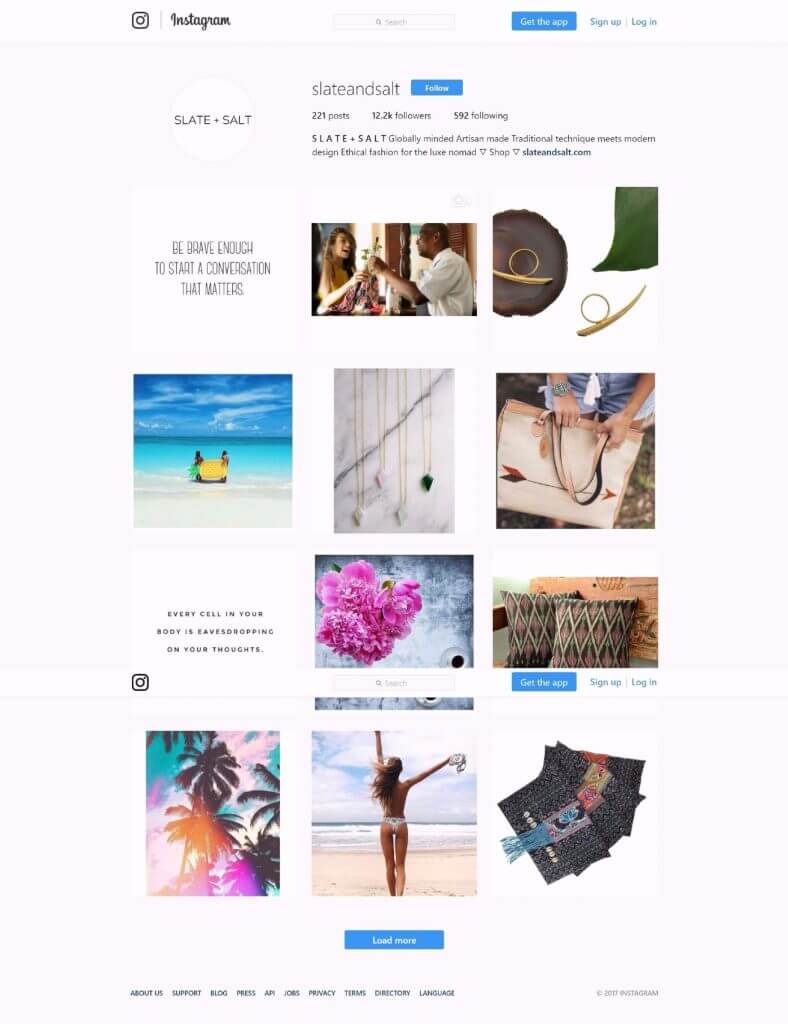
Hugues focuses on Instagram over Facebook.
For one thing, Facebook is full of advertisers–5 million to be exact–and Hugues feels there’s too much noise for a new brand to stand out.
“I don’t feel that people are on Facebook as much anymore, and they’re bombarded by more ads than ever,” explains Hugues. “Instagram is great because it’s all photography, which is great for apparel and home goods…and you can build relationships with influencers and customers better [than on Facebook].”
In addition, Hugues noticed a distinct drop in reach once she switched her Facebook page over to a “business” page in February.
“We started to get a lot less traffic because they want you to pay,” says Hugues. “If I had known that I probably wouldn’t have ever changed it into a business page.
“When it comes to online advertising, you have to pay to play. Nothing is free.” – Lyndsay Hugues, Founder of SLATE + SALT
Retargeting Site Visitors on Social
The ecommerce site runs on Shopify. While Hugues isn’t a huge fan of most advertising options on Facebook for businesses, she’s found retargeting on Facebook and Instagram via the Shopify app to be incredibly useful.
“You have to constantly target people,” says Hugues. “[Social marketing] in general is something I need to stay on top of, because when I do post daily, traffic goes up on the site.”
Influencer Posts
So far, Hugues hasn’t had to work to find great influencers. All she does is share photos of ethical/fair trade/vegan bloggers and influencers, and many of them reached out to request an opportunity to represent the brand.
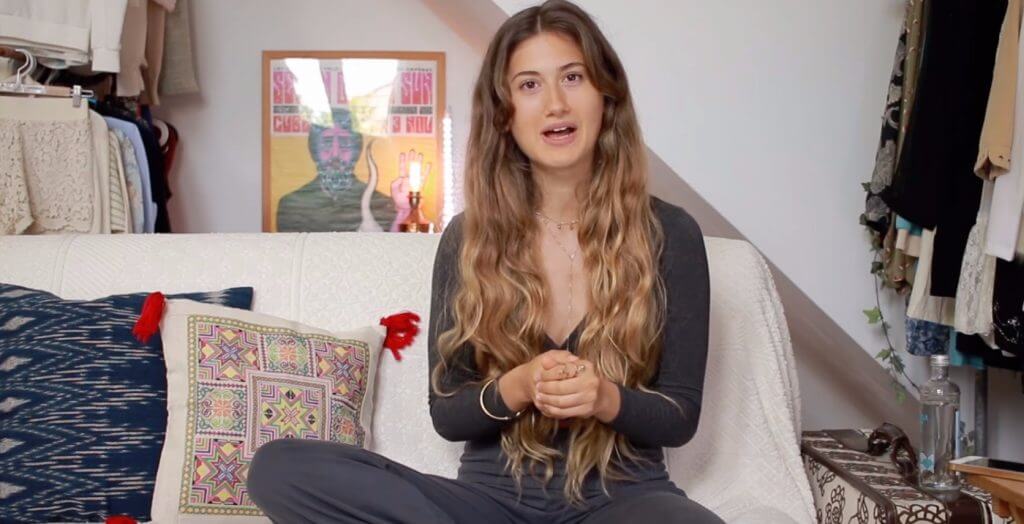
Considering many influencers come with a high price tag (and some risks depending on what they post), Hugues is cautious about who she works with.
We decide who to work with based on their aesthetic and ethos, how much they charge, and their traffic,” says Hugues. Sometimes all they want is free product in exchange for their posts. Other times, they charge an exorbitant amount for a post and they don’t get as much traffic as they claim. You just have to do your research on everyone and choose who makes sense.
The Biggest Challenges of Selling Fair Trade Products Online
Don’t Assume Your Customer Knows Your Story
The biggest problem a lot of fair trade brands run into?
When you can buy a wool blanket on Amazon for a steal, it’s difficult to justify the higher cost for a product from a fair trade brand or retailer.
The thing is–customers don’t always understand what goes into a higher price tag. – Lyndsay Hugues, Founder of SLATE + SALT
“It seems a lot like people don’t want to buy anything unless they get a discount,” says Hugues. “The brand is about the fair trade concept, and a lot of people don’t even know what fair trade is. Customers don’t always understand what goes into a higher price tag.”
Normally, fair trade products are more expensive. Artisans are paid far more than they would be in a sweatshop. Additionally, Hugues specifically seeks out artisans who use special techniques–for instance, in the way they weave a blanket–that have been passed down through generations.
This is a big reason why Hugues has an “about the artisans” page on the website.
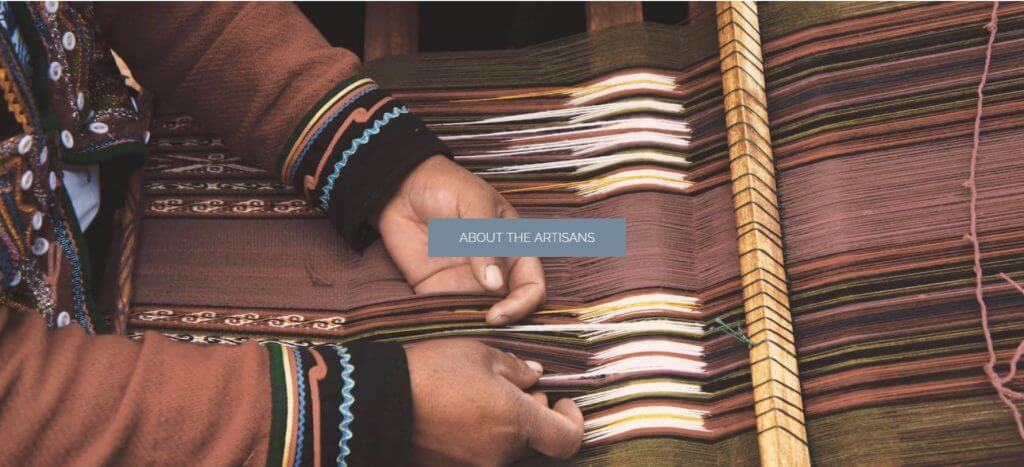
“We’re trying to explain to people where it’s made and why it’s special,” says Hugues.”Not just so they’ll understand why they must pay more, but also because it’s an interesting story and it makes people prouder to wear something.”
Ethically Sourcing Products is Harder Than You Think
It all started when Hugues traveled through Southeast Asia and went shopping.
“On the first trip, I saw things that would sell great in the states,” says Hugues. “And I thought maybe I would start importing from Bali and Thailand because they sell really cute, cheap, and trendy things.”
Then Hugues discovered the dark secret about the creation of those cute, cheap, trendy products–the majority of them were made by workers who were frequently underage, worked in appalling conditions, and paid poorly.
“I traveled more and saw firsthand the way these communities lived, and I knew i couldn’t source products the same way,” says Hugues. “So I spent six months backpacking and sourcing products from different local groups and individuals.”
Now, Hugues orders her products from a mix of those personal contacts and from ethical manufacturers. (And one of these things is much, much harder than the other.)
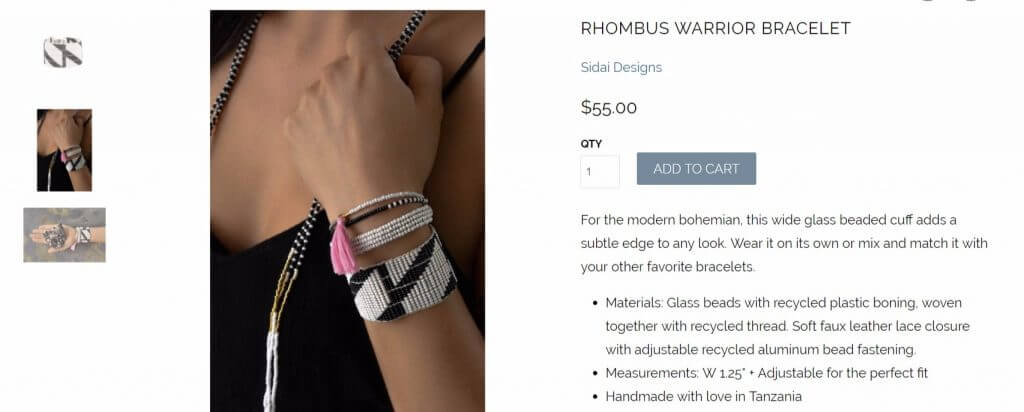
“Its definitely harder to source yourself directly,” says Hugues. “I’ve sourced from other ethical manufacturers who I can pay with a credit card, and there’s no language barrier, and they ship on time.”
But to Hugues, it’s worth the headaches.
For instance, she purchases cashmere from Nepalese artisans she met herself. The artisans are in fact deaf and blind, and they weave beautiful blankets and scarves. She loves supporting them.
However, the business side is slightly chaotic.
The last time I made a purchase from them, it took a month texting back and forth determining what I wanted. They actually ship the product before they’ve been paid, so when my payment through Western Union took a couple days to reach them, they were worried the money wasn’t coming, and there were issues. And when I got the order, it was messed up. They’ve actually messed up a lot of my orders, but they’re so great and I love their cause.
China has long been the favorite source of retailers looking for cheaper manufacturing. Would Hugues ever source from a factory in China she’s never been to?
Not a chance–even if the factory claimed to hold to fair trade standards.
“I’m only sourcing from places I’ve been and people I’ve met, or established fair trade brands so I know they’re legitimate,” says Hugues. “I’m building a brand based on ethical practices, and I want us to always be who we say we are.”

Be Prepared to Put Up Money (and a Lot of It)
From the start, Hugues was surprised how much money she had to spend on marketing and advertising online.
“You have to pay to play with anything now–especially with social media,” says Hugues. “Nothing is free anymore, and I didn’t realize how much it would actually cost.”
Hugues spent the greater part of a year working on a business plan that included competitors, her demographic, and her budget. That budget has proven to be crucially important as the business grows.
“If you run out of money and you don’t spend appropriately, then you’re not going to survive,” Huges says.
Of course, we couldn’t interview Hugues without getting her take on selling on Amazon. Well, turns out she’s attempted the application process before, but stopped when she realized how much time it would take.
“I’ve considered it, but we’re working on selling via smaller retailer sites right now, and we’re focusing on building our brand,” explains Hugues.
Whether or not she chooses to sell on Amazon, the behemoth has shaped many aspects of her marketing strategy:
“Amazon is the reason we’re doing free shipping. Even I don’t even want to pay for shipping!”
You Might Be Interested In










